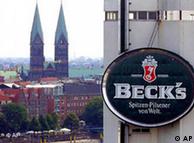原在陳巨擘先生的從紐約時報看天下:"大家好:我們好久沒有一起品酒了,這個星期我們來讀一篇有關品酒的文章過過癮。這篇登在第一版最底下:Mischievous Odes to the Joys of Drinking by Dwight Garner.
這 篇文章基本上是已故英國小說家 Kingsley Amis最近有人幫他出版的一本書(由已絕版的三本書結合而成)"Everyday Drinking" 的書評。這本書告訴讀者如何喝酒喝得很有品味,同時也告訴讀者如何解決宿醉(hangover)的問題。有趣的是,Amis把宿醉分成 physical hangover(身體的宿醉)和 metaphysical hangover(形而上的宿醉)。其中以解決形而上的宿醉最有趣。Amis建議去讀米爾頓的《失樂園》、索忍尼辛的小說等等。什麼是形而上的宿醉?大家 可以從文章裡找到答案。大家要注意的是,metaphysical 這個形容詞雖然是 meta + physical,它的名詞是 metaphysics。但 physical 這個字可以表示身體的,也可以表示自然法則,所以自然科學或物理科學是 physical science。所以,metaphysical hangover大家就可以從這兩方面去聯想,英文常有這種雙關的含意,很難用中文去傳達,體會就好,不必去追究確切的意思。
另外標題上的 michievous有頑皮和惡意兩種意思,這兩種行為好像只有一線之隔,很有意思。大家可以看看作者的用意是前者還是後者?還是兩者都有?"
HC 幫忙查字典
Definition
imbibe Show phoneticsverb
1 [I or T] FORMAL OR HUMOROUS to drink, especially alcohol:
Have you been imbibing again?
2 [T] to receive and accept information, etc.
souse Show phonetics
verb [T]
to put something into a liquid, or to make something completely wet
soused Show phonetics
adjective
1 (of fish) preserved in salty water or vinegar:
soused herring/mackerel
2 OLD-FASHIONED INFORMAL drunk
Toasting the Joys of Imbibing Properly
Got a hangover? Search Google, and you’ll find a thousand home remedies, from mild palliatives (buttermilk, honey, bananas) to shock therapy (pickle juice, kudzu extract, raw cabbage). If you can drag yourself into Walgreens or Rite Aid, there’s usually a potion or two that promises relief.

Kingsley Amis in 1989.
EVERYDAY DRINKING
The Distilled Kingsley Amis
By Kingsley Amis
302 pages. Bloomsbury. $19.99.

The problem with these cures, the British novelist Kingsley Amis (1922-95) wrote in his now-classic 1972 book “On Drink,” is that they deal only with the physical manifestations of a hangover. What also urgently needs to be treated, he observed, is the metaphysical hangover — “that ineffable compound of depression, sadness (these two are not the same), anxiety, self-hatred, sense of failure and fear for the future” that looms on the grizzled morning after.
Amis’s ideas for curing a physical hangover were fairly routine, though a few of the crazier ones will make you laugh. (“Go up for half an hour in an open aeroplane, needless to say with a non-hungover person at the controls.”)
His notions about fixing a metaphysical hangover are where things got interesting. Amis recommended, among other things, a course of “hangover reading,” one that “rests on the principle that you must feel worse emotionally before you start to feel better. A good cry is the initial aim.”
Thus he suggested beginning with Milton — “My own choice would tend to include the final scene of ‘Paradise Lost,’ ” he wrote, “with what is probably the most poignant moment in all our literature coming at lines 624-6” — before running through Aleksandr Solzhenitsyn, Eric Ambler and, finally, a poulticelike application of light comedies by P. G. Wodehouse and Peter De Vries.
It was a witty, bravura performance, this essay on the hangover, and rereading it now is a reminder of how good all of Amis’s writing was about being what he called a “drink-man”: smart, no-nonsense and, above all else, charming.
Before he was knighted in 1990, Amis published three books about the judicious but enthusiastic consumption of alcohol: “On Drink,” “Everyday Drinking” in 1983 and “How’s Your Glass?” in 1984. Long out of print, these volumes have finally been gathered together and reissued under a single cover, topped off with a fizzy introduction by Christopher Hitchens. These books are so delicious they impart a kind of contact high; they make you feel as if you’ve just had the first sip of the planet’s coldest, driest martini.
Amis was an unorthodox guide to the drinking arts. “Not much of a wine man,” he nonetheless drank it and wrote about it often and well. He preferred spirits and beer, and complained about wine snobs and the “pro-wine pressure on everybody.” Among his essays is one titled “The Wine-Resenter’s Short Handy Guide.”
Amis mostly wrote about preparing cocktails at home, for one’s self and for guests. He stressed, again and again, the importance of making a genuine effort. “Serving good drinks,” he wrote, “like producing anything worth while, from a poem to a motor-car, is troublesome and expensive.”
While he looked for ways to trim costs, Amis loathed all forms of social stinginess. (“With alcoholic ritual,” Mr. Hitchens writes in his introduction, “the whole point is generosity.”) One essay collected here — it deserves to be rediscovered and widely anthologized — is “Mean Sod’s Guide,” a tongue-in-cheek tutorial about how to “stint your guests on quality and quantity” while seeming to have done them very well. Among his tips for a host determined not to pour too many drinks: “Sit in a specially deep easy-chair, and practice getting out of it with a mild effort and, later in the evening, a just-audible groan.”
Throughout his life Amis was absurdly quotable on almost every topic, but on imbibing especially. On diets: “The first, indeed the only, requirement of a diet is that it should lose you weight without reducing your alcoholic intake by the smallest degree.” On why serious drinkers should own a separate refrigerator for their implements: “Wives and such are constantly filling up any refrigerator they have a claim on, even its ice-compartment, with irrelevant rubbish like food.” On the benefits of sangria: “You can drink a lot of it without falling down.”
As anyone who has read Zachary Leader’s 2007 biography of Amis knows, alcohol did unspool his mind a bit at the end. But you finish this book, and Mr. Leader’s, believing that it added more to his life than it took away.
Amis wrote with feeling about alcohol’s place in society. “The human race,” he noted, “has not devised any way of dissolving barriers, getting to know the other chap fast, breaking the ice, that is one-tenth as handy and efficient as letting you and the other chap, or chaps, cease to be totally sober at about the same rate in agreeable surroundings.” And he could not help observing the way that “hilarity and drink are connected in a profoundly human, peculiarly intimate way.”
Did I mention that “Everyday Drinking” has recipes? Amis described the effects of his tequila-based version of a Bloody Mary (you’ll want to try it) this way: “a splendid pick-me-up, and throw-me-down, and jump-on-me. Strongly disrecommended for mornings after.”







